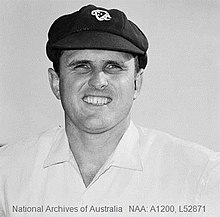Tom Veivers
 Veivers in 1965 | ||||||||||||||||||||||||||||||||||||||||
| Personal information | ||||||||||||||||||||||||||||||||||||||||
|---|---|---|---|---|---|---|---|---|---|---|---|---|---|---|---|---|---|---|---|---|---|---|---|---|---|---|---|---|---|---|---|---|---|---|---|---|---|---|---|---|
| Full name | Thomas Robert Veivers | |||||||||||||||||||||||||||||||||||||||
| Born | 6 April 1937 Beenleigh,Queensland,Australia | |||||||||||||||||||||||||||||||||||||||
| Batting | Left-handed | |||||||||||||||||||||||||||||||||||||||
| Bowling | Right-arm offbreak | |||||||||||||||||||||||||||||||||||||||
| Relations | Jack Wildermuth(great nephew) | |||||||||||||||||||||||||||||||||||||||
| International information | ||||||||||||||||||||||||||||||||||||||||
| National side | ||||||||||||||||||||||||||||||||||||||||
| Test debut (cap226) | 6 December 1964 vSouth Africa | |||||||||||||||||||||||||||||||||||||||
| Last Test | 29 February 1967 vSouth Africa | |||||||||||||||||||||||||||||||||||||||
| Career statistics | ||||||||||||||||||||||||||||||||||||||||
| ||||||||||||||||||||||||||||||||||||||||
Source:[1],10 October 2021 | ||||||||||||||||||||||||||||||||||||||||
Tom Veivers | |
|---|---|
| Member of theQueensland Legislative Assembly forAshgrove | |
| In office 22 October 1983 – 1 November 1986 | |
| Preceded by | John Greenwood |
| Succeeded by | Alan Sherlock |
| Personal details | |
| Nationality | Australian |
| Political party | Labor |
| Spouse | Robyn Stutterd (m.1960) |
| Relations | Mick Veivers(cousin),Greg Veivers(cousin) |
| Occupation | Teacher |
Thomas Robert Veivers(born 6 April 1937) is an Australian formercricketer,teacher, politician and public administrator who played in 21 cricketTest matchesbetween 1963 and 1967. He is the great-uncle ofJack Wildermuth.[1]
Cricket career[edit]
Veivers was anall-rounderwho bowled right-armoff-spinand batted left-handed. Educated atDownlands College,inToowoombain southeasternQueensland,he attended theUniversity of Queensland,whom he represented in club cricket. In 1955, playing for Downlands College in a match against Gregory Terrace at the Brisbane Oval, he scored 155 runs. He was made the captain of the Queensland Colts and scored 126 against the New South Wales Colts in 1958/59, their first win in the interstate Gregory Cup in 8 years.[citation needed]
He made hisfirst-classdebut in 1958–59 against the touringEnglish cricket teamand made hisSheffield Shielddebut that season also. He did not command a regular spot in the Sheffield Shield team until the following season. He was selected for his firstAustralian squadin 1962, playing in anAustralian XI against the visiting English team,in which he was hit for two sixes byTed Dexterin his opening over.[citation needed]
John WoodcockofThe Timeswrote: "I doubt if it is possible to hit a cricket ball any harder than Dexter did today. Melbourne is a huge ground and no one who hits a six here is likely to forget it. Against Veivers, an off-spinner, Dexter twice cleared the sightscreen, once by a good 20 yards."[2]In the 2 matches against the MCC, his figures were 3 wickets for 310 and he was considered for the Test matches.[citation needed]
Veivers was selected for the Test team the following season to make his debut againstSouth Africain the First Test inBrisbane,in which he scored 14 batting at number 8 and took 1/48. He was omitted for the third and fourth Tests, but managed to defy the South Africans with stubborn batting in the fifth Test inSydney,salvaging a draw. He touredEnglandin 1964, playing all Tests and scoring two half-centuries and three three-wicket hauls. He followed this with 2 more half-centuries and a career-best of 4/68 on the tour toIndia.While scoring 74 in Chennai he hitBapu Nadkarni,often considered an unhittable bowler, for 3 sixes.[citation needed]
He scored his Test best of 88 against Pakistan in Australia the following season but was unavailable to tour theWest Indiesin 1965 for personal reasons. He had a difficult1965-66 Ashes seriesback home against England, taking just four wickets and one half-century. He went on the 1966-67 tour ofSouth Africa,which was his last international representation for Australia. He retired from first-class cricket the following year.[citation needed]
His bowling was economical but not penetrative, with a Test average of over 40. He bowled one of the longest known bowling spells in Test cricket - 55 six-ball overs in England's innings of 611 at Old Trafford in 1964. Veivers bowled 75 of the last 80 overs delivered from the City end and finished with figures of 95.1-36-155-3. This is the highest number of balls bowled in an innings of a Test match by an Australian and included a single unbroken spell of 51 overs and one ball. Veivers was the non-striker when Simpson reached the 300 and, one Test later, whenFred Truemantook his 300th wicket by dismissingNeil Hawke.[citation needed]
Later career[edit]
Veivers was a Brisbane radio station executive before serving as the secretary of theQueensland Cricket Associationfrom 1974 to 1977 and a state selector from 1977 to 1982.[citation needed]
He had a brief political career, holding the seat ofAshgrovein theLegislative Assembly of Queenslandfrom 1983 to 1986 for theLabor Party.[3]He was Commissioner-General of the Australian Pavilion at World Expo 88 in Brisbane in 1988. He was Chairman of the Queensland Institute of Medical Research Trust from 1991 to 2000 and was appointed a Fellow of the Institute in 2000.[citation needed]
He was the president of the QCA from 1989 to 1992. He was made a Life Member of Queensland Cricket in 2006.[4]
His cousins,MickandGreg Veivers,both represented forAustraliaat rugby league, Greg captaining the national team. Mick went on to become a Queensland state politician. His great-nephew,Jack Wildermuth,has playedTwenty20 International(T20I) cricket for Australia.[5]
References[edit]
- ^"Jack Wildermuth great uncle Tom Vievers".ESPN cricinfo.Retrieved13 September2022.
- ^John Woodcock,The Times,10 November 1962
- ^"Former Members".Parliament of Queensland.2015.Retrieved4 February2015.
- ^"Annual Report 2016-2017".Queensland Cricket.Retrieved20 January2020.
- ^"Jack Wildermuth's England experience will be very different to that of his great uncle Tom Veivers".The Courier Mail.Retrieved6 March2019.
External links[edit]
- 1937 births
- Living people
- Australia Test cricketers
- Australian cricket administrators
- Australian cricketers
- Australian Labor Party members of the Parliament of Queensland
- Australian sportsperson-politicians
- Members of the Queensland Legislative Assembly
- Queensland cricketers
- Veivers family
- Cricketers from Queensland
- Politicians from Queensland
- People from South East Queensland
- People educated at Downlands College
- Queensland cricket captains
